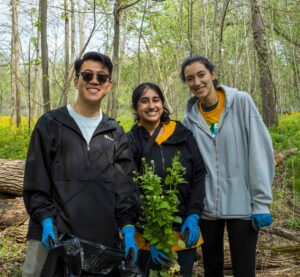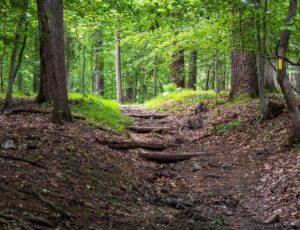Natural Resource Conservation
The C&O Canal National Historical Park is beloved by millions for its natural beauty, rich recreational opportunities, and accessibility for millions of visitors. What is less well known is that it is one of the most biologically diverse national parks in the nation. Since its creation in 1971, over 1,500 plant species have been identified in the park, including over 200 rare, threatened, or endangered (RTE) plants, some of which are globally rare and unique.
The C&O Canal is classified as facing imminent failure regarding forest regeneration, due to pressures from habitat degradation, forest pests, white-tailed deer, and invasive species. In response, the National Park Service (NPS) has initiated a comprehensive restoration project to encourage forest regeneration and the restoration of other habitats. These threats impact RTE plant populations across the park. Between 2008 and 2021, just over 100 previously identified RTE species were found along the C&O Canal. The remaining plants are likely now locally extinct. Invasive non-native plants, regional urbanization, and surging visitation have all taken their toll on the fragile habitats that make such diversity possible. The NPS is facing complex challenges to conserve this national biodiversity treasure. Its ability to meet these challenges, however, is severely impacted by capacity constraints resulting from ongoing shortfalls in the NPS operating budget.
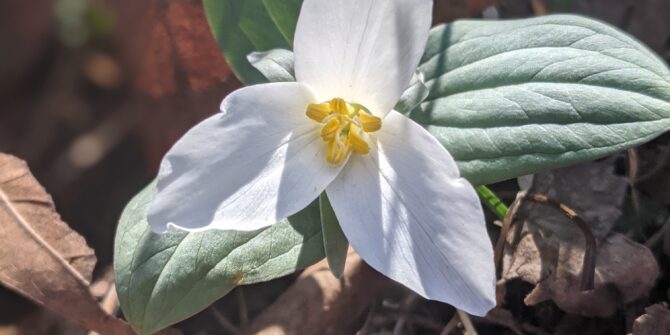
Snow Trillium (Trillium nivale) is a woodland, perennial wildflower that typically flowers between mid-March to early April. These plants grow in areas where there many other plants cannot, such as in limestone-dense outcroppings or areas where the soil is more gravely and sandy. Global Rank: G4, State Rank: S1 (Critically Imperiled). Photo by NPS.
Native plants are adapted to provide food and shelter for native animals who have evolved alongside these plants. Protecting and propagating native plants helps ensure that the park’s ecosystems remain healthy and balanced, supporting local wildlife, soil, and water quality. This includes roughly 200 rare, RTE plants. With support from the Trust in 2024, C&O Canal natural resources staff worked to conserve RTE species and planted almost 3,000 individual RTE propagules across spring and fall planting seasons.
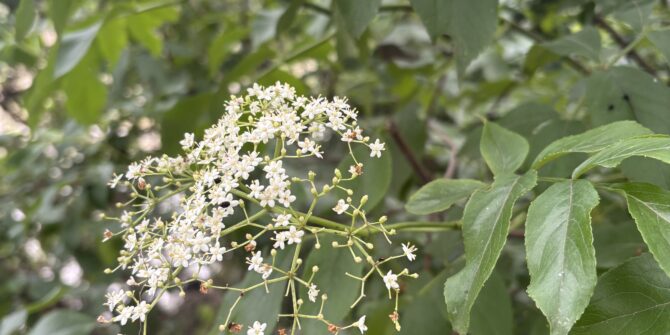
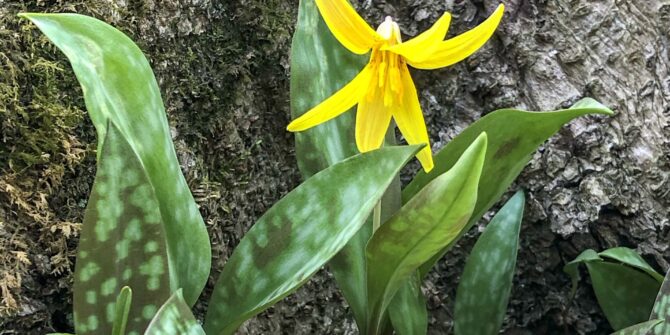
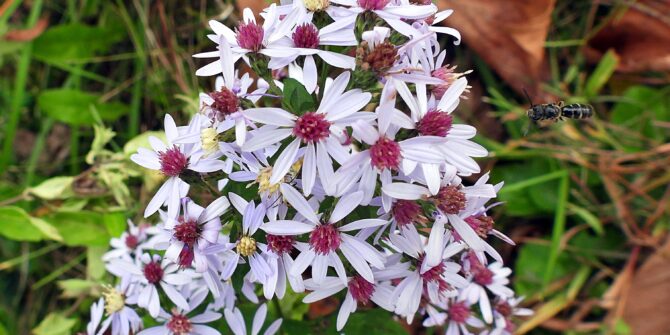
Invasive species have growing patterns that allow them to spread quickly, outcompeting native plants for essential resources like water, sunlight, and space. Non-native invasive species often lack natural predators, leaving their growth unchecked. As the concentration of invasive species rises, the park becomes an increasingly unsuitable habitat for creatures who call the C&O Canal home. The NPS and the Trust work together to manage invasive species through coordinated removal efforts. NPS staff also use specialized equipment and treatment plans to target aggressive invasive species throughout the park.
The C&O Canal Trust has raised over $300,000 to support C&O Canal Natural Resource initiatives, thanks to our generous donors.
To date, natural resources staff have planted nearly 2,000 individual propagules from 13 species, with a survival rate of 90-95%.
We are committed to preserving and protecting our park’s incredible natural resources, but we need your help. Together, we can make a difference and ensure the park’s biodiversity remains for years to come.
With planning underway for the much-needed rehabilitation of the Billy Goat Trail System near Great Falls, the park turned to the Trust in 2020 to request funding to support a youth botany fellowship program to survey RTE plants in and around the area. With over 100 RTE plant species, the Potomac Gorge, where the trails are located, is considered a top biodiversity “hotspot,” and is also the area of the park most imperiled by exceptionally high visitor numbers. The purpose of the survey was to collect data from known rare plant populations and identify other threatened species to ensure that work on the trail system is sensitive to fragile habitats and endangered plants. The park uses this information to identify and relocate at-risk plants or collect seed for their propagation. These efforts allow the park to ensure the continued survival of the plant species while providing sought-after outdoor recreational opportunities. As the C&O Canal’s official philanthropic partner, the Trust was able to provide an initial grant of $64,757 to support this important work.
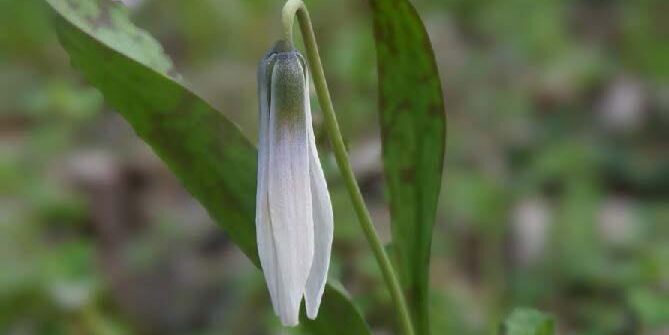
White Trout Lily (Erythronium albidum) is a great pollinator and nutrient pool for other plants. These plants bloom in early spring and soak up many important nutrients from the soil, such as nitrogen and phosphorus. In the summer, when the blooms have disappeared and the plants die back, they release these nutrients back in the soil, providing nearby growing plants with the proper nourishment to sustain the warmer season. Global Rank: G5, State Rank: S2 (Imperiled). Photo by NPS.
For more information, please contact the development team at [email protected].
FREQUENTLY ASKED QUESTIONS
Why is the C&O Canal so biologically diverse?
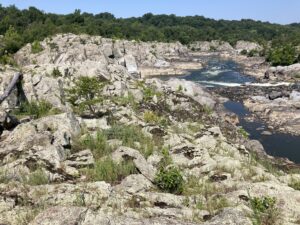
The C&O Canal spans 184.5 miles, traversing four physiographic provinces. From the Appalachian Mountains, through the Blue Ridge Mountains and the rolling farmland of the Piedmont, to its terminus on the Atlantic Coastal Plain in Georgetown, the park contains a rich mosaic of different habitats that host 68 distinct plant communities, 12 of which are globally unique. These habitats are the result of a variety of geological formations, most notably the Potomac Gorge and the shale barrens of the Appalachian range. Frequent flooding along the Potomac causes tree canopy gaps, scouring, and silt and seed deposition along the length of the river. Many northern and southern plant species overlap in the park, with isolated populations of western species surviving where prairie habitat persists along the Potomac. Such diversity extends to fauna, which depend upon these varied ecological niches to thrive.
Along the Potomac Gorge, the geology and hydrology of the river flowing over Great Falls has created a biodiversity “hotspot” comprised of the most diverse flora located within an urban area on the entire East Coast. Upriver, the shale barrens of Allegany and Washington Counties, constitute a globally rare natural community where RTE plant and animal species are adapted to its harsh conditions. The steep slopes, constantly weathering shale, and continual undercutting of the Potomac limits soil development leading to the evolution of rare, endemic species found nowhere else in the world.
How does the park propagate RTE plant species?
The park is focused on facilitating the long-term conservation of RTE plant species throughout the C&O Canal through a partnership with the Mt. Cuba Center, a nonprofit native plant garden in Delaware, with a strategy that includes comprehensive identification, monitoring, habitat protection, seed collection, plant propagation, and establishing new populations of RTE plants in unique habitat niches in the park. To ensure success, however, the park needs the help of our canal community to supplement available NPS funding.
What conservation projects are the park working on?
The park is working on restoring the Gold Mine Tract in the C&O Canal. Situated in the highly developed urban area of Potomac, MD, the 600-acre Gold Mine Tract provides unparalleled access to trails and recreational opportunities. The NPS has initiated a comprehensive restoration project to encourage forest regeneration. NPS staff have already planted over 100 native trees and shrubs in the Gold Mine Tract to combat the threats of habitat degradation, invasive species, white-tailed deer, and other forest pests.
To support this restoration initiative, the Trust received the Perennial Garden Club’s 75th Anniversary Grant for Native Plants. The Perennial Garden Club is a member of the Garden Club of America, a national organization cultivating the bond among people, plants, and the environment. Thanks to the generosity of its members, the Trust will work in partnership with the National Park Service and engage a native plant and forest restoration specialist to assist with the restoration process. We also look forward to working with PGC members as volunteers to provide early maintenance support for this essential project. This grant will at least double the park’s efforts and enable the restoration of additional acres in the Gold Mine Tract. These plantings will lay the groundwork for a new population of mature native trees, increasing canopy resilience and ensuring connected habitats remain. The project will also increase biodiversity by planting a variety of trees and understory plants, furthering the forest’s resiliency for years to come.
Photo by Francis Grant-Suttie
Photo credit: Chris Reif, Trust Staff, Kelly Hilton, Francis Grant-Suttie

